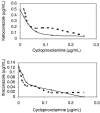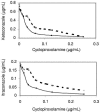Establishing a method of inoculum preparation for susceptibility testing of Trichophyton rubrum and Trichophyton mentagrophytes
- PMID: 16390955
- PMCID: PMC1351939
- DOI: 10.1128/JCM.44.1.98-101.2006
Establishing a method of inoculum preparation for susceptibility testing of Trichophyton rubrum and Trichophyton mentagrophytes
Abstract
A total of 92 clinical isolates of dermatophytes (52 of Trichophyton rubrum and 40 of Trichophyton mentagrophytes) were selected for testing with six antifungal drugs (terbinafine, griseofulvin, clotrimazole, miconazole, isoconazole, and fluconazole) and two pairs of drug combinations (ketoconazole-cyclopiroxolamine and itraconazole-cyclopiroxolamine). Two methods of inoculum preparation for susceptibility testing were evaluated that used (i) inocula consisting only of microconidia of dermatophytes filtered in Whatman filter model 40 and (ii) unfiltered inocula consisting of hyphae and microconidia. We followed the recommendations of approved document M38-A of CLSI (formerly NCCLS) with some adaptations, including an incubation period of 7 days and an incubation temperature of 28 degrees C. Reference strains of Candida parapsilosis, Candida krusei, Trichophyton rubrum, and Trichophyton mentagrophytes were included as quality-control strains. MICs were consistently higher (usually 1 to 2 dilutions for drugs tested individually) when nonfiltered inocula were tested (P < 0.01) except for terbinafine. Larger MICs were seen when testing drugs with nonfiltered inocula. The curves of drug interaction were used to analyze the reproducibility of the test, and it was shown that high levels of reproducibility were achieved using the methodology that included the filtration step. The standardization of methodologies is the first step to yield reliability of susceptibility testing and to proceed with clinical laboratory studies to correlate MICs with clinical outcomes.
Figures


References
-
- Aberkane, A., M. Cuenca-Estrela, A. Gomez-Lopes, E. Petrikkou, E. Mellado, A. Mozón, J. L. Rodríguez-Tudella, and Eurofung Network. 2002. Comparative evaluation of two different methods of inoculum preparation for antifungal susceptibility testing of filamentous fungi. J. Antimicrob. Chemother. 50:719-722. - PubMed
-
- Espinel-Ingroff, A., M. Bartlett, R. Bowden, N. X. Chin, C. Cooper, Jr., A. Fothergill, M. R. McGinnis, P. Menezes, S. A. Messer, P. W. Nelson, F. C. Odds, L. Pasarell, J. Peter, M. A. Pfaller, J. H. Rex, M. G. Rinaldi, G. S. Shankland, T. J. Walsh, and I. Weitzman. 1997. Multicenter evaluation of proposed standardized procedure for antifungal susceptibility testing of filamentous fungi. J. Clin. Microbiol. 35:139-143. - PMC - PubMed
MeSH terms
Substances
LinkOut - more resources
Full Text Sources

